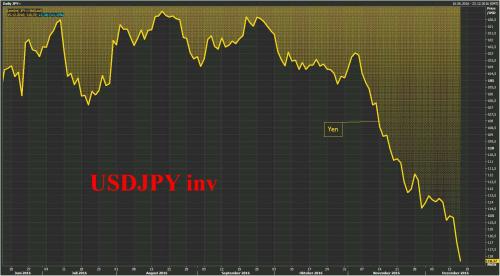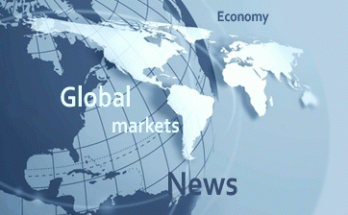This morning the world awakes to a landscape in which markets are frantically rushing to catch up to a suddenly hawkish Fed which not only hiked for the second time in a decade but, as per yesterday’s Fed statement and Yellen press conference, realized it has been behind the curve all along, and the result has been a spike in the dollar across virtually all currency pairs with the USD/JPY surging above 118.40, coupled with a jump in bond yields around the globe as bond (the US 10 Year is trading at 2.64%, the highest since September 2014) as traders dump any hint of duration.
The sentiment was notable in the analyst commentary this morning:
- “The Fed is becoming a leopard with new spots,†said Stephen Gallo, currency analyst at BMO Capital Markets in London. “The Fed has shifted its 2017 bias away from supporting growth with ultra-stimulative policies towards keeping a lid on inflation risk.â€
- “Maybe Fed officials are more concerned about the prospects for a rise in inflation next year than they are letting on, given the potential boost a fiscal stimulus could bring, which was something they didn’t have to consider last year,†Michael Hewson, a market analyst at CMC Markets in London, wrote in a note.
- “You had the Fed come in and be a bit more hawkish that many people, including us, were expecting,” said TD Securities head of global strategy Richard Kelly. “It wasn’t just the move in the dots, it was the language that was used. There was an acknowledgement that if Trump gets his plans moving through congress you could see the economy pushing higher.”
DB’s Jim Reid had a different angle: it will be all about the volatility in rates in the coming year, as the Fed has officially unleashed the inflationary genie out of the bottle.
People in my profession have perhaps been guilty of over analysing the Fed in recent years when every small nuance was over examined when in reality they really haven’t done much over this period. However last night’s statement and press conference was full of interesting remarks and certainly landed on the hawkish side with the dots edging up with the median dot now showing 3 hikes for 2017 rather than 2 beforehand. Last night’s meeting broke a trend as prior to this, the last six FOMCs have seen treasury yields fall with the last seven seeing the dollar fall against the Euro. Not this time. The meeting fits in with our view that markets are vulnerable to a bond yield spike next year. Rates vol could be the main talking point of 2017.
In equities, after yesterday’s drop, the biggest since the election, Asian stocks fell but European equities rose driven by financials while S&P futures are already getting the BTFD treatment and trying to make up for Thursday’s drop .
It wasn’t just the Fed tightening monetary policy. Shortly after the Fed announcement, virtually all Gulf Arab states followed suit out of necessity to keep their dollar pegs. As Bloomberg notes, policy makers in Saudi Arabia, the United Arab Emirates, Kuwait, Bahrain and Qatar raised borrowing costs within hours after the Fed raised its benchmark rate for the first time this year. The prospect of further increases in U.S. rates next year will complicate efforts to bolster economic growth and ease a cash squeeze among Gulf banks as revenue from oil exports, the region’s main source of income, plummets.
However, while stocks are modestly higher, the big story this morning is all about the Dollar, which continues its relentless surge higher, in the process pushing the USD/JPY, as the Yen tumbles over 1%, and sending the pair to 118.30, the highest level since the start of the year…

… but more notably the Euro, which moments ago also plunged by 1% to 1.043, dropping to the lowest level since January 2003.

The dollar also extended its advance against all major and emerging-market peers.

The bloodbath was not confined to FX, however, as global government bonds were left reeling this morning, with the 10Y Treasury spiking to 2.64%, the highest level in over two years, while European bonds likewise tumbled, sending 10Y yields surging as follows:
- Spain +6bps at 1.46%;
- Italy +6bps at 1.85%,
- Portugal +4bps at 3.82%,
- German +7bps at 0.37%;
- Dec. bund futures -95 ticks at 161.51
This all follows this morning record crash in Chinese bond futures, which sent local 10Y yields higher by 22 bps, the most on record, to 3.45%, as a plunging yuan and hawkish Fed comments damped expectations of monetary easing in China.

In early trading, stocks were ignoring the momentous moves in FX and rates, and for now stocks in Europe and US futures traded higher, with the Stoxx Europe 600 Index rising 0.3 percent, led by banks.Randgold Resources Ltd., Fresnillo Plc and Centamin Plc fell more than 7 percent with declines in precious metals, while Electricite de France SA sank the most on record after saying profit will drop next year. The VStoxx Index declined 9 percent to the lowest level since September 2014, signaling traders are pulling back from hedging against swings in euro area shares.
In the U.S., futures on the S&P 500 Index were up about 0.2% after the equity gauge posted its biggest loss in two months on Wednesday, however should the bond collapse continue we fear the green will quickly shift to red.
* * *
Bulletin Headline Summary From RanSquawk
- European bourses enter the North American crossover higher with financials outperforming
- USD strength remains the key theme in FX markets with USD/JPY remaining north of 118.00
- Looking ahead, highlights include SNB, Norges Bank, BoE rate decisions, US CPI, Philadelphia Mfg Index, NY Empire and Weekly Jobs

